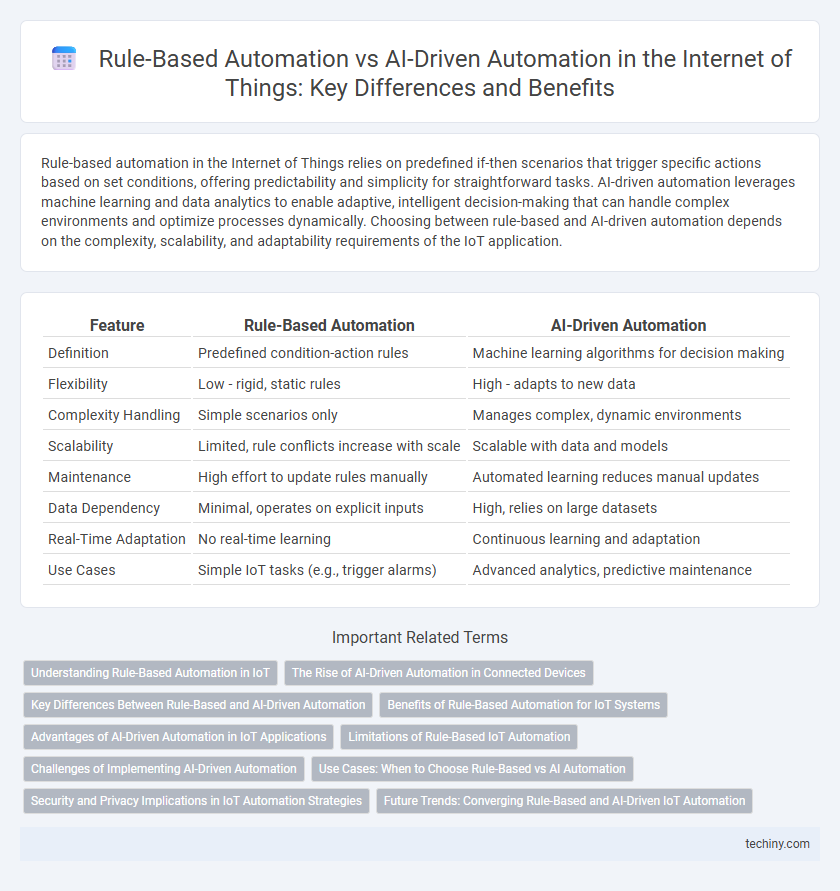Rule-based automation in the Internet of Things relies on predefined if-then scenarios that trigger specific actions based on set conditions, offering predictability and simplicity for straightforward tasks. AI-driven automation leverages machine learning and data analytics to enable adaptive, intelligent decision-making that can handle complex environments and optimize processes dynamically. Choosing between rule-based and AI-driven automation depends on the complexity, scalability, and adaptability requirements of the IoT application.
Table of Comparison
| Feature | Rule-Based Automation | AI-Driven Automation |
|---|---|---|
| Definition | Predefined condition-action rules | Machine learning algorithms for decision making |
| Flexibility | Low - rigid, static rules | High - adapts to new data |
| Complexity Handling | Simple scenarios only | Manages complex, dynamic environments |
| Scalability | Limited, rule conflicts increase with scale | Scalable with data and models |
| Maintenance | High effort to update rules manually | Automated learning reduces manual updates |
| Data Dependency | Minimal, operates on explicit inputs | High, relies on large datasets |
| Real-Time Adaptation | No real-time learning | Continuous learning and adaptation |
| Use Cases | Simple IoT tasks (e.g., trigger alarms) | Advanced analytics, predictive maintenance |
Understanding Rule-Based Automation in IoT
Rule-based automation in IoT relies on predefined condition-action pairs to trigger specific device responses, ensuring predictable system behavior and straightforward implementation. This approach is highly effective for scenarios with simple logic and deterministic outcomes, such as controlling smart lighting or activating alarms based on sensor data thresholds. Unlike AI-driven automation that adapts through data learning, rule-based systems depend on explicit programming, limiting flexibility but providing transparency and ease of troubleshooting.
The Rise of AI-Driven Automation in Connected Devices
AI-driven automation in connected devices surpasses rule-based automation by enabling adaptive decision-making through real-time data analysis and machine learning algorithms. Unlike static rule-based systems that rely on predefined instructions, AI-driven solutions continuously learn from user behavior and environmental changes to optimize performance and enhance device interoperability. This evolution accelerates smart home innovation, predictive maintenance, and energy management, driving efficiency and user experience in Internet of Things ecosystems.
Key Differences Between Rule-Based and AI-Driven Automation
Rule-based automation operates on predefined scripts and fixed logic, making it ideal for predictable IoT tasks like scheduled device control, but it struggles with complex data variability. AI-driven automation leverages machine learning algorithms to analyze real-time IoT data, enabling adaptive decision-making and predictive maintenance for smart devices. Key differences include flexibility, scalability, and the ability to handle unstructured data, where AI outperforms rigid rule-based systems in dynamic IoT environments.
Benefits of Rule-Based Automation for IoT Systems
Rule-based automation in IoT systems offers precise control by executing predefined actions based on specific conditions, ensuring reliability and predictability in device interactions. This method simplifies implementation and maintenance due to its straightforward logic, enabling fast response times crucial for real-time IoT applications. Rule-based systems also provide transparency and easy troubleshooting, which enhances system security and compliance in industrial and smart home environments.
Advantages of AI-Driven Automation in IoT Applications
AI-driven automation in IoT applications offers superior adaptability by leveraging machine learning algorithms to analyze vast datasets and predict system behaviors, enabling more accurate and dynamic decision-making compared to static rule-based systems. It enhances operational efficiency through real-time data processing and anomaly detection, optimizing device performance and reducing downtime in complex IoT networks. Furthermore, AI-driven automation supports scalability and continuous improvement by learning from new data inputs, facilitating intelligent responses in diverse and evolving environments.
Limitations of Rule-Based IoT Automation
Rule-based IoT automation depends on predefined scripts and fixed conditions, which limits its adaptability to dynamic environments and complex scenarios. It struggles with scalability and cannot efficiently process large volumes of diverse sensor data or learn from real-time interactions. These limitations make rule-based systems less effective for predictive maintenance and advanced anomaly detection compared to AI-driven automation.
Challenges of Implementing AI-Driven Automation
Implementing AI-driven automation in the Internet of Things faces significant challenges, including the need for vast amounts of high-quality, diverse data to train machine learning models effectively. Integration complexities arise due to the heterogeneous nature of IoT devices and protocols, requiring robust frameworks to ensure seamless communication and interoperability. Additionally, ensuring data privacy and security while maintaining real-time processing capabilities poses critical obstacles in deploying scalable AI-driven automation systems.
Use Cases: When to Choose Rule-Based vs AI Automation
Rule-based automation excels in predictable, repetitive tasks such as simple device control and predefined alert systems in smart homes and industrial IoT, ensuring reliability and ease of implementation. AI-driven automation is ideal for complex scenarios requiring adaptive learning, like predictive maintenance in manufacturing and dynamic energy management, where data patterns evolve over time. Choosing between these approaches depends on factors like task complexity, data variability, and the need for real-time decision-making in IoT deployments.
Security and Privacy Implications in IoT Automation Strategies
Rule-based automation in IoT relies on predefined scripts, which can be rigid and vulnerable to emerging security threats due to their limited ability to adapt. AI-driven automation enhances security by continuously learning from data patterns, enabling real-time anomaly detection and proactive threat mitigation. Privacy concerns rise with AI models handling sensitive data, necessitating robust encryption, data anonymization, and strict access controls to safeguard user information.
Future Trends: Converging Rule-Based and AI-Driven IoT Automation
Future trends in Internet of Things (IoT) automation reveal a convergence between rule-based systems and AI-driven technologies, enabling more adaptive and context-aware environments. Hybrid models leverage predefined rules for predictable operations while integrating machine learning algorithms to handle complex, dynamic data patterns. This fusion optimizes real-time decision-making, enhances operational efficiency, and drives smarter IoT ecosystems across industries.
rule-based automation vs AI-driven automation Infographic

 techiny.com
techiny.com